The country is likely to receive ‘below-normal’ monsoon rains during June-September period at 94% of the benchmark with an average error margin of +/- 5%, private weather forecaster Skymet on Monday said.
If the forecast holds good, the country would receive below normal rainfall this year after four consecutive years of ‘normal or above normal’ precipitation. Skymet said that rainfall during the June-September period that provides more than 70%of the country’s annual precipitation is expected to be at 816.5 millimeters as against the normal benchmark of 868.8 mm.
The agency predicted that there is an increasing likelihood of development of El-Nino in Asia, which could become dominant during the monsoon months.
Also Read: Skymet predicts ‘searing’ summer; forecast raises concerns over FY24 agri growth
“The likelihood of El Nino is increasing, and its probability to become a dominant category during the monsoon is growing large. El Nino return may presage a weaker monsoon,” Jatin Singh, Managing Director, Skymet, said.
In terms of monthly variations in the distribution of rains, the Skymet has predicted rainfall to be in the normal range at 99% of the benchmark, while rest of three months – July, August and September, crucial for the sowing of kharif crops such as paddy, pulses and oilseeds is likely to be below normal range 95%, 92% and 90% of benchmark respectively.
The India Meteorological Department will release its first monsoon forecast on Tuesday.
Recently Mrutyunjay Mahapatra, Director General, IMD had said that El Nino which weakens the intensity of monsoon rains which is currently at the neutral stage. However he said that there is a strong possibility of a weather phenomenon developing during June-September period as predicted by many global models.
“It can’t be said with certainty at this point of time as to what exact impact El Nino will have on the Indian monsoon because in the past all El Nino years haven’t been bad monsoon years,” Mohapatra said.
In terms of regional distribution, the skymet expects northern and central parts of the country may get deficient rainfall especially Gujarat, Madhya Pradesh and Maharashtra during July and August.
In north India, Punjab, Haryana, Rajasthan and Uttar Pradesh are likely to receive below normal rains in the second half of the monsoon months.
Meanwhile, the monsoon and foodgrains data for the decade indicate that despite patchy and uneven performance of monsoon rains over the years, its impact on India’s foodgrains production has been marginal.
Also Read: Independent PDMA given a quiet burial
For instance, monsoon rains were 12% below the benchmark in 2014 while the food grain production in the 2014-15 crop year (July-June) declined by 5% to 252 million tonne (MT) compared to previous crop year.
In 2018, monsoon rains were 9% below the normal benchmark, the production of rice, wheat and pulses did not fall in the 2018-19 crop year compared to previous year.
“Deficient monsoon rains largely do not impact rabi or winter crops like wheat, pulses and oilseeds as these crops mostly have irrigation facilities,” CSC Sekhar, professor, Institute of Economic Growth, University of Delhi, said.
According to an agriculture ministry official, the government’s procurement of rice and wheat is carried out mostly in those states such as Punjab, Haryana, Madhya Pradesh and Telangana which mostly have irrigation facilities thus minimising impact of deficient monsoon rains.

